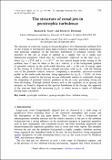Files in this item
The structure of zonal jets in geostrophic turbulence
Item metadata
| dc.contributor.author | Scott, Richard Kirkness | |
| dc.contributor.author | Dritschel, David Gerard | |
| dc.date.accessioned | 2013-09-20T23:27:39Z | |
| dc.date.available | 2013-09-20T23:27:39Z | |
| dc.date.issued | 2012-11 | |
| dc.identifier | 22397313 | |
| dc.identifier | ed1f0e7e-89ae-4598-abe9-0ada595fa54d | |
| dc.identifier | 84870052193 | |
| dc.identifier.citation | Scott , R K & Dritschel , D G 2012 , ' The structure of zonal jets in geostrophic turbulence ' , Journal of Fluid Mechanics , vol. 711 , pp. 576-598 . https://doi.org/10.1017/jfm.2012.410 | en |
| dc.identifier.issn | 0022-1120 | |
| dc.identifier.other | ORCID: /0000-0001-5624-5128/work/55378689 | |
| dc.identifier.other | ORCID: /0000-0001-6489-3395/work/64697726 | |
| dc.identifier.uri | https://hdl.handle.net/10023/4064 | |
| dc.description.abstract | The structure of zonal jets arising in forced-dissipative, two-dimensional turbulent flow on the β-plane is investigated using high-resolution, long-time numerical integrations, with particular emphasis on the late-time distribution of potential vorticity. The structure of the jets is found to depend in a simple way on a single nondimensional parameter, which may be conveniently expressed as the ratio LRh/Lg, where LRh = √U/β and Lg = (ε/β3)1/5 are two natural length scales arising in the problem; here U may be taken as the r.m.s. velocity, β is the background gradient of potential vorticity in the north–south direction, and ε is the rate of energy input by the forcing. It is shown that jet strength increases with LRh/Lg, with the limiting case of the potential vorticity staircase, comprising a monotonic, piecewise-constant profile in the north–south direction, being approached for LRh/Lg ∼ 0(10). At lower values, eddies created by the forcing become sufficiently intense to continually disrupt the steepening of potential vorticity gradients in the jet cores, preventing strong jets from developing. Although detailed features such as the regularity of jet spacing and intensity are found to depend on the spectral distribution of the forcing, the approach of the staircase limit with increasing LRh/Lg is robust across a variety of different forcing types considered. | |
| dc.format.extent | 2390250 | |
| dc.language.iso | eng | |
| dc.relation.ispartof | Journal of Fluid Mechanics | en |
| dc.subject | Geostrophic turbulence | en |
| dc.subject | Quasi-geostrophic flows | en |
| dc.subject | Turbulent mixing | en |
| dc.subject | QA Mathematics | en |
| dc.subject.lcc | QA | en |
| dc.title | The structure of zonal jets in geostrophic turbulence | en |
| dc.type | Journal article | en |
| dc.contributor.sponsor | The Leverhulme Trust | en |
| dc.contributor.institution | University of St Andrews. Applied Mathematics | en |
| dc.contributor.institution | University of St Andrews. Marine Alliance for Science & Technology Scotland | en |
| dc.identifier.doi | 10.1017/jfm.2012.410 | |
| dc.description.status | Peer reviewed | en |
| dc.date.embargoedUntil | 2013-09-21 | |
| dc.identifier.grantnumber | N/A | en |
This item appears in the following Collection(s)
Items in the St Andrews Research Repository are protected by copyright, with all rights reserved, unless otherwise indicated.

